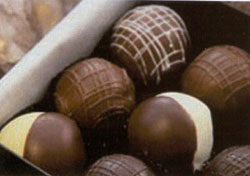| 2003 |

|
YEAR BOOK |
Teagasc - Dairy Products Research Centre, Moorepark, Fermoy, Co. Cork
|
Improved milk powder for chocolate
|

In our trials, cocoa butter (20%), cocoa liquor (32%), sugar (43%) and milk powder (25%) were first weighed out and mixed. Because particles greater than 25 micrometers are grainy in the mouth, the chocolate was first refined by passing the mix twice between revolving drums called rollers. The refined powder mix was then conched, that is converted to the liquid state by heating to 60�C and stirring over 7 hours. The flow properties of the hot liquid chocolate were then further improved by the addition of 0.2% lecithin. Carefully controlled conditions were used to cool the liquid chocolate in order to crystallise the cocoa butter in the most stable form.
Studies were carried out to make spray-dried milk powders with improved properties for chocolate. Milk powders were produced with various levels of fat, protein, moisture and air cells. The higher fat powders were blended with skim milk powder to give a standard 26% fat powder. Fat extractability from the milk powder, termed free-fat, increases with fat content and protein content. The particle size of the mixed ingredients after refining decreased as the fat content of the milk powder increased, even when blended with skim milk powder to the same fat content. Smaller particle size is expected to lead to poorer flow properties, but in this case, the flow properties improved because of the greater effect of the higher free-fat content of the high-fat milk powders.
The free-fat content of the milk powders also increased with the protein content of the powders. However, in this case, the higher protein contents counteracted the beneficial effects of the higher free-fat levels of the milk powders. The particle size of the milk powders also increased with the moisture content of the powders, but improvements in the flow properties of the chocolate did not result. The volume of air cells in the milk powder particles decreased primarily with increasing fat content, which in turn improved the flow properties of the chocolate.
These studies show that it is possible to make good chocolates using high-fat/skim milk powder blends with high free-fat and low air cell contents.
Contact: Dr Kieran Keogh; Tel: 025-42235; E-mail: [email protected]